
The temple exterior and entranceway. The interior temple resembles the style of the marble arches.
This magical-looking place nestled in the rolling green fields of Robbinsville, New Jersey is a Hindu temple, the BAPS Shri Swaminarayan Mandir. The temple, or mandir, is one of approximately 100 in the United States and 1,000 globally. The grand exterior, or mandap, houses the inner sanctum, the actual mandir, and the entire complex is is an “akshardham”. By definition, “mandir” in ancient Sanskrit means “means a place where the mind becomes still and experiences inner peace“. The atmosphere upon arrival is immediately uplifting and reflected through pleasant exchanges with devotees and visitors on the way into and within the mandir.

Beautiful floral entry
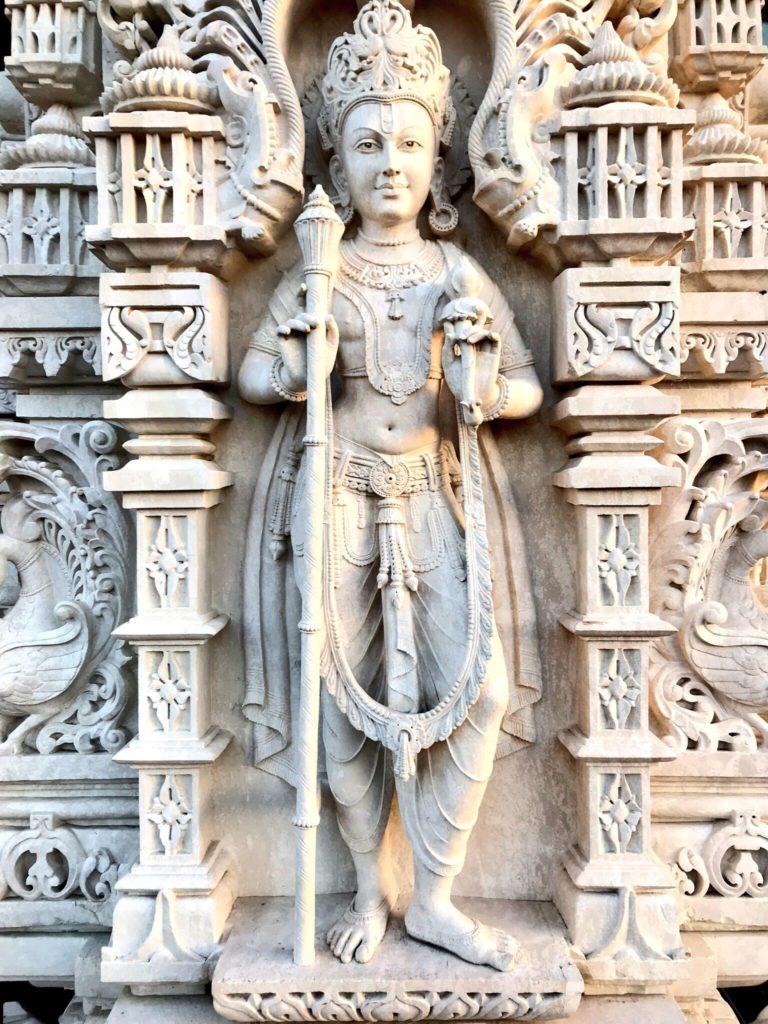
Magnificent temple sculptures
Art, Architecture, and the Divine
The Robbinsville temple is in the Nagara style of Hindu mandir architecture found in Northern India. Nagara style temples are square with graduated projections and towers that give the mandir height. Characteristic features in addition to the towers are domes, golden spires, flags, the sanctum, and pillared halls. Each has symbolic meaning like the pinnacles, aspiration, the golden spires, the immortality of the soul, and the flags, spiritual attainment. The inner sanctum is where one will find the most important deities. These elements of temple architecture combined create a link between devotees and the Divine.
The temple’s style is not purely architectural. The Robbinsville mandir is built according to Scripture as are all traditional mandirs. This influence of religion on architecture echoed in a recent tour of Central Park when the staff guide mentioned that the landscape designers Frederick Law Olmsted and Calvert Vaux took inspiration directly from the Bible to create serene pastoral settings, though the mandir follows specifications for scared architecture. These sacred temples are not exclusively traditional. More modern temples, hari mandirs, are smaller, and ghar mandirs, shrines within devotees’ homes, are where families perform rituals and discuss scripture together.
The BAPS Shri Swaminarayan Mandir is made of white marble, white limestone, and pink sandstone, selected to last in this cooler climate. As the mandir’s introductory film notes, the use of natural stone is similar to that of iconic spiritual centers like St. Patrick’s Cathedral and Angkor Wat. The stone-carving process is extensive and fascinating. For an idea of the undertaking, artisans in India created the sculptures. Many volunteer, but the carving also provides work to skilled artists whose talents are not in demand as they once were. The marble is primarily Italian Carrara, totaling 68,000 cubic feet, and the limestone is from Bulgaria and India. The sculptured stone, some 13,499 pieces, arrived in Robbinsville 98% complete after a journey of 21,500 miles. Additional volunteers finished the work. All this is breathtaking, but it does not prepare one for the splendid interior of the mandir with white marble and golden statues that appear silver in the lamplight. The sacred images, or murtis, within the mandir and on the pillars in the mandap are not just deities, but “living works of art” and “liberated souls…ancient sages, and exemplary devotees” that are models of spiritual inspiration.
What may surprise visitors is that the grand, beautiful temple holds fast with interlocking stone. Quotes from the Rig Veda, hymns in ancient Sanskrit, are inspiring poetry in stone that one can read throughout the temple. Skylights and white marble floors add to the lightness of the interior. The tradition of the lamplight in the mandir pre-dates electricity and skylights and once provided the only light in the temple within the temple. Among the sculptures, visitors will see peacocks, particularly at the entrance gate, which are the national bird of India, and elephants, which represent “resolve, grace, and nobility”. One devotee mentioned that the elephant is honored for the many centuries when it carried stone to build the mandirs in the days before other transportation. Ganesh, the popular deity known as the Lord of Good Fortune, the Lord of Beginnings, and the Remover of Obstacles, who is also important in Bhuddism, is depicted with the head of these beloved animals that reflect different accounts of his origin.
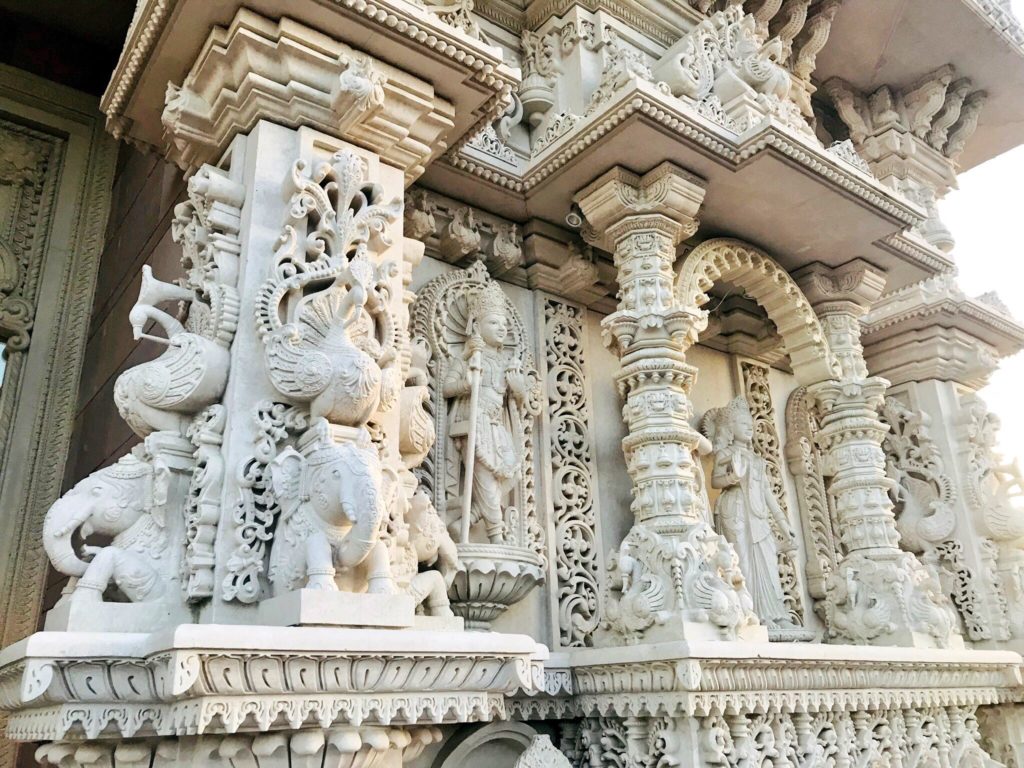
Entranceway

BAPS Shri Swaminarayan Mandir
Bochasanwasi Akshar Purushottam Sanstha (BAPS) is a branch of Swaminarayan Hinduism. Devotees believes that Bhagwan Swaminarayan, or the yogi spiritual leader, was God on earth and his Divine presence continues through succession. The Swaminaryran, also referred to as “Swaminaryran Lord,” was born as Ghanshyam Pande (1781-1830). His philosophy led to social reforms in India. His follower, Shastriji Maharaj (1865-1951), a sadhu and Sanskrit scholar, or holy man of ancient Hindu letters, formed BAPS on June 5, 1907 based on his interpretation of the Swaminarayan’s teachings. One of his successors, His Holiness Pramukh Swami Maharaj, blessed this site in August 2014. The present spiritual leader of BAPS, His Holiness, Mahant Swami Maharaj, bestowed his blessing in September 2017.
BAPS in Robbinsville continues the ancient Hindu tradition of “worshipping the Divine through murtis, or sacred images, enshrined in mandirs”. The BAPS communities worldwide focus on spiritual living, family values, and community service. Though the mandir has a respectful quiet on a visit, rituals and festivals involve music. The mandir also offers Indian cultural events and celebrations for devotees in the great hall.
“A place of paramount peace” is an apt description. While walking through the beautiful inner mandir, devotees brushed aside concerns about interrupting them at prayer. The devotees warmly shared aspects of their faith and excitement at the near completion of the spiritual center. Construction on this mandir began in 2010 and though it is complete, the mahamandir, a greater temple, reportedly the largest in the world, is under construction adjacent to the mandap where there will also be a youth center and an exhibition hall which will feature “Indian history and culture”.
Visiting
The mandir is an active house of worship. Visitors are welcome to take photos outside, but the temple kindly requests a respectful covering regarding clothing and no photo-taking inside. Please respect their wishes. For visitor information, please see BAPS Shri Swaminarayan Mandir.
The visit is free, but donations, however modest, are welcome as a thank you. Reservations are not required for individuals or families, but do call for larger groups: (609) 918-1212. Upon arriving, you will be asked to remove your shoes as a respectful courtesy. The welcome is most cordial with the gift of prasadam (“prasad” grace and joy), a sanctified sweet, for each visitor. An introductory film and a free guided tour with a volunteer will add to your appreciation of the temple. If a guide is not available, the audio tour is excellent, and the book available to visitors at the welcome desk is helpful as an introduction to both the mandir and Hinduism. There is a snack shop and café.
To the right of the entrance, one may participate in the ritual of abhishek, or pouring water over the “sacred image of God,” here, Shri Ghanshyam Marahaj, the childhood form of Bhagwan Swaminarayan. Though the deities may seem confusing initially to those who are not familiar with Hinduism, the belief is that there is one supreme God, Brahman, the creator. Along with Shiva, who preserves the earth, and Vishnu, who destroys the earth so it can be created anew, the three are both one and separate in a mystical way like the Holy Trinity. All the deities and even devotees are the Divine presence on earth. “That which we call the Hindu religion is really the Eternal religion because it embraces all others.” The temple guidebook complements this thought, “Without the deities, the mandir would be no more than a beautiful building. With them, it becomes a sacred place of worship wherein God resides”.
There is so much to see and the atmosphere is so peaceful that you will want to return. We had wonderful practicing neighbors while growing up, but my knowledge of Hinduism is more academic going back to incredible studies as an exchange student at Bowdoin College. This visit is was a welcome opportunity to talk to people about their faith without being intrusive. Devotees were warm and gracious in doing so as well as proud and excited to share their beautiful spiritual home. By no means is this modest travelogue definitive about BAPS or Hinduism, so please do enjoy a visit yourself to learn more.
In researching, this Hindu proverb stood out as a cornerstone of many faiths, “There is nothing noble about being superior to some other man. The true nobility is being superior to your previous self.” The faith that brings the mandir’s stones to life is indeed at the heart of its beauty.
(Sources: www.baps.org/Global-Network/North-America/Robbinsville.aspx, BAPS publication for visitors and visitor film, bbc.co.uk, definitions.net, kashgar.com.au, Swami Sivananda quote, Sri Aurobindo quote, iasmania.com, americanshipper.com, Britannica.com, Wiki)
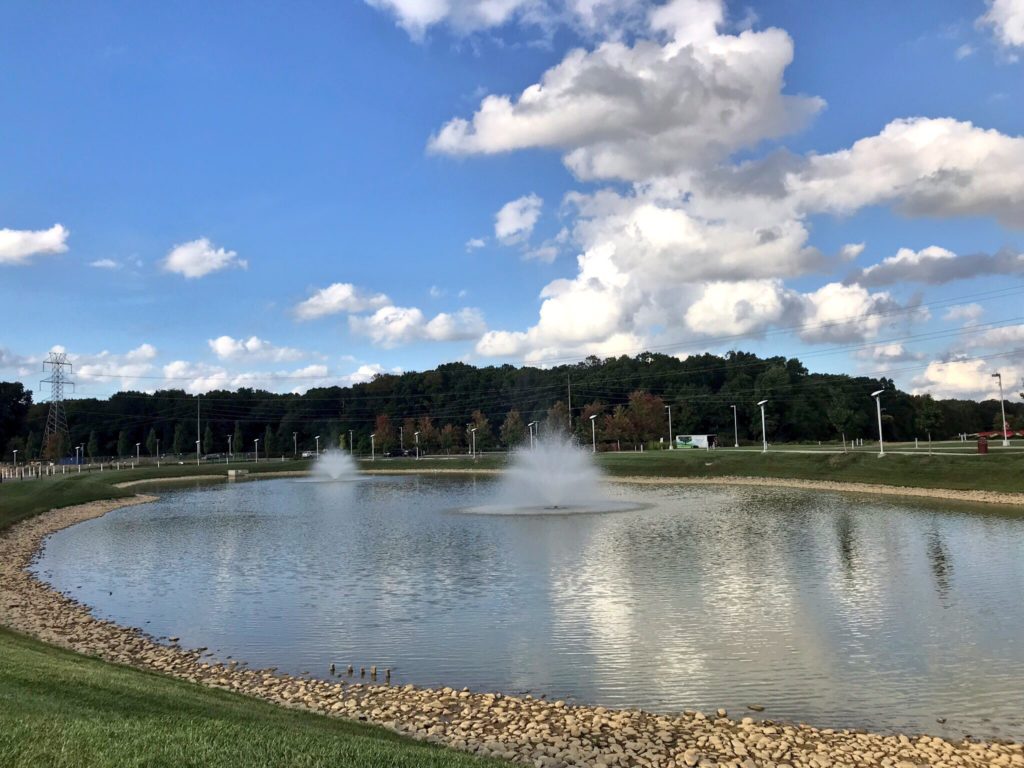
Beautiful grounds
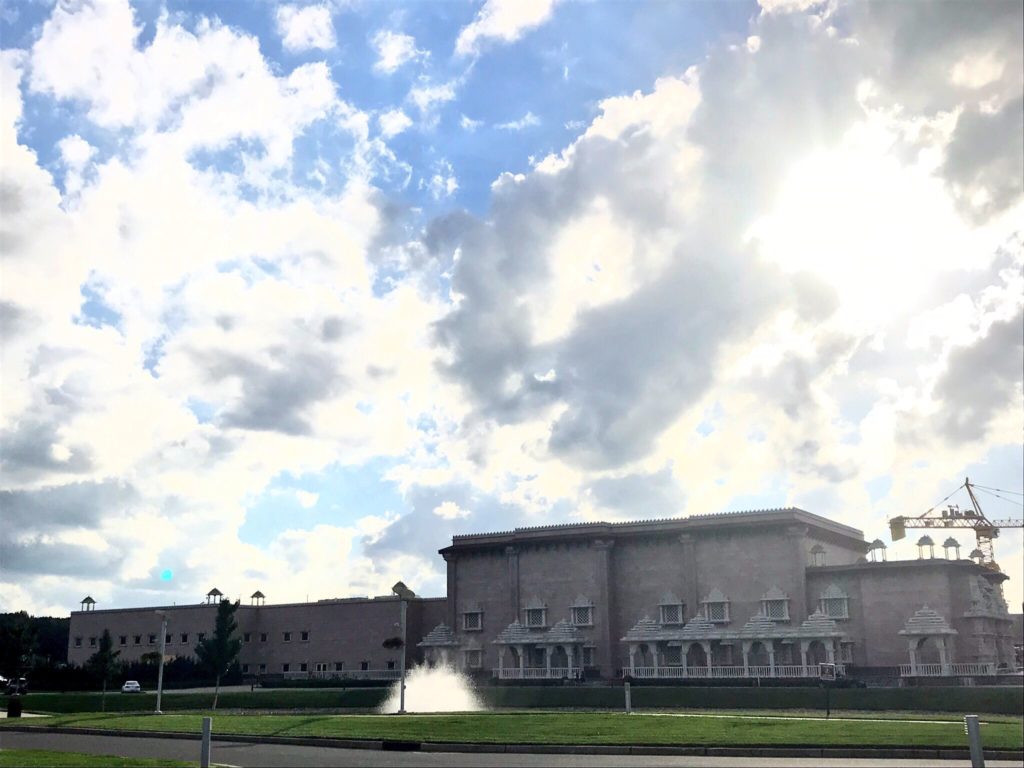
Behind the striking temple exterior (mandap), the construction continues to complete the center (akshardham).
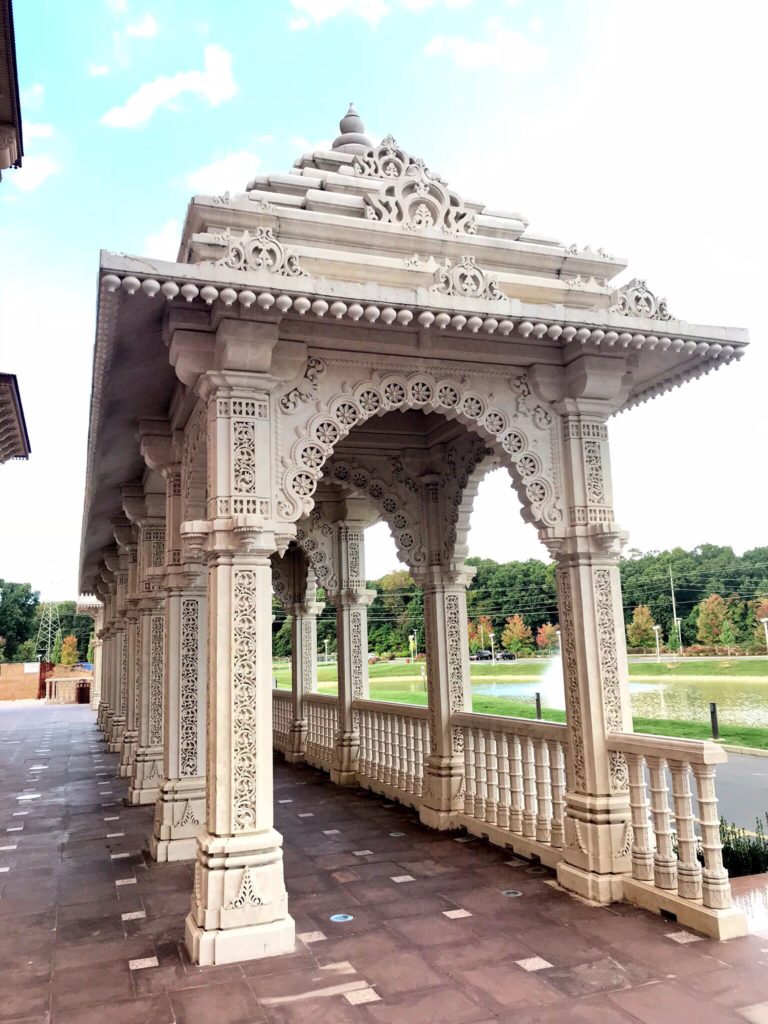
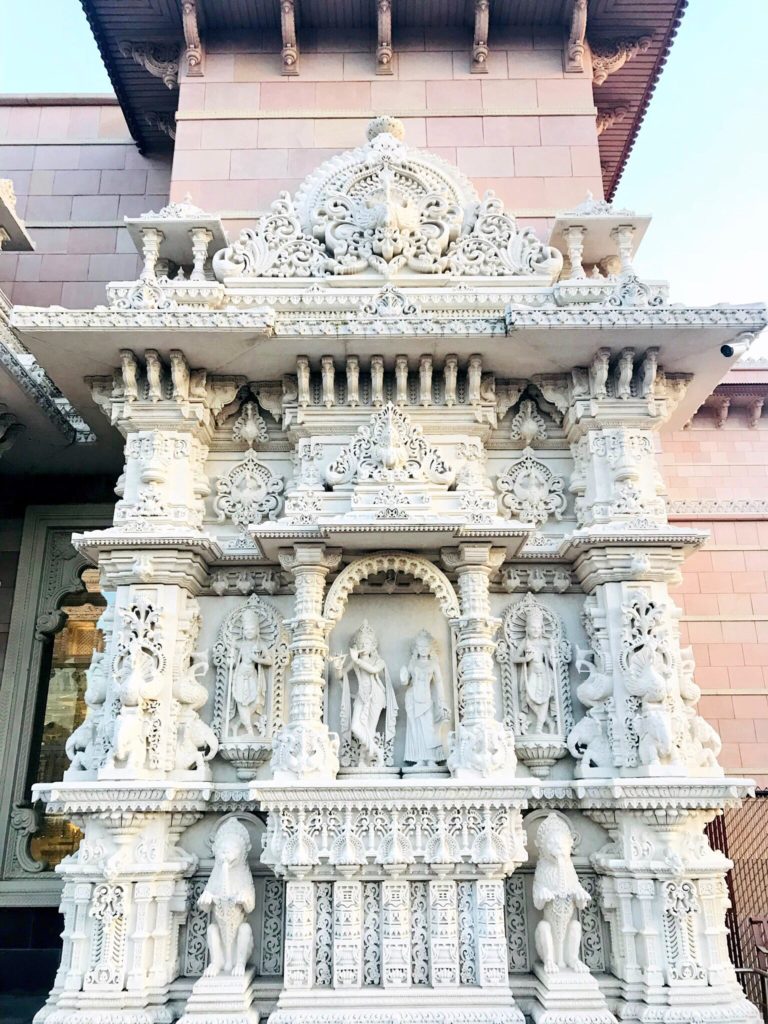
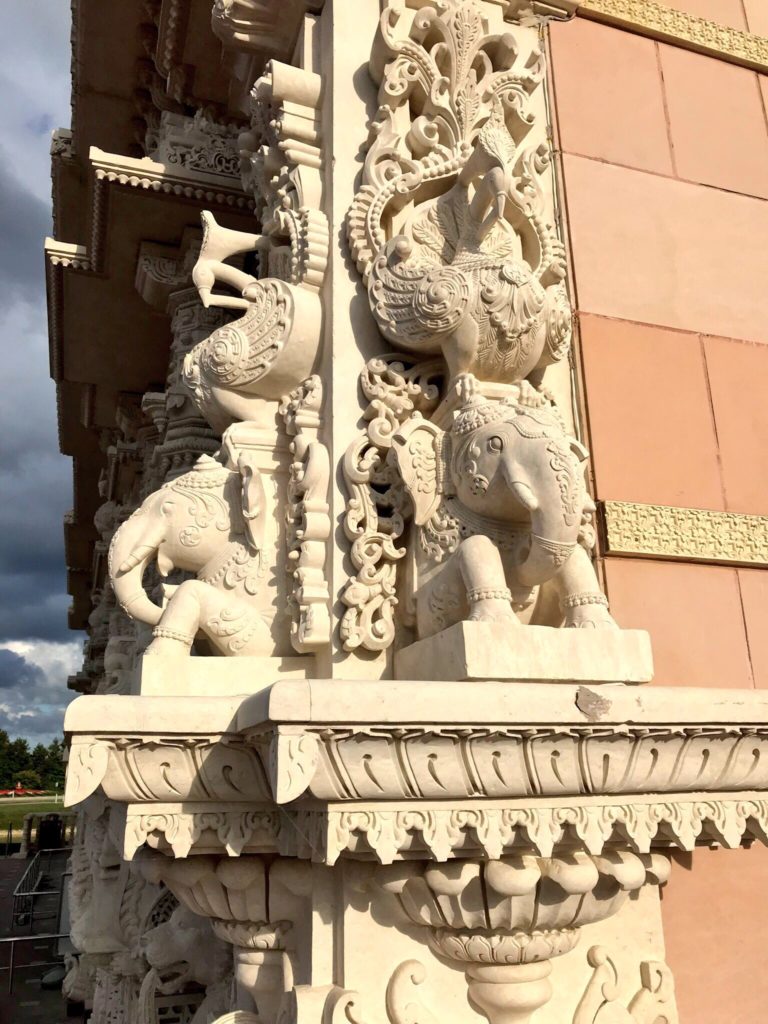
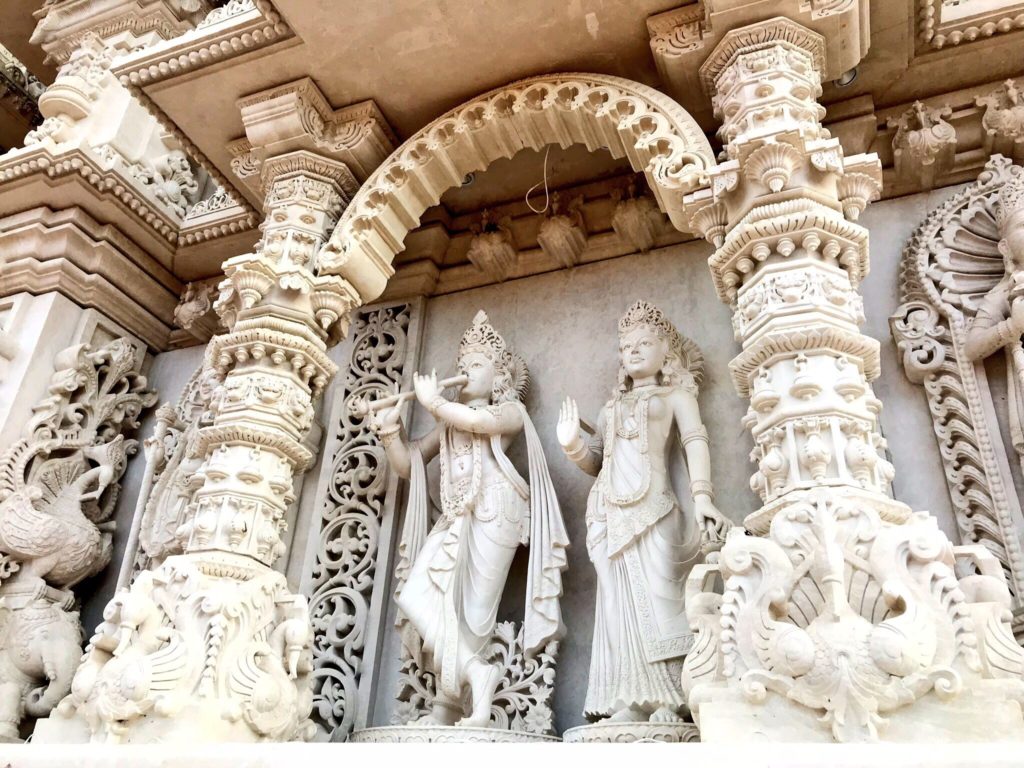
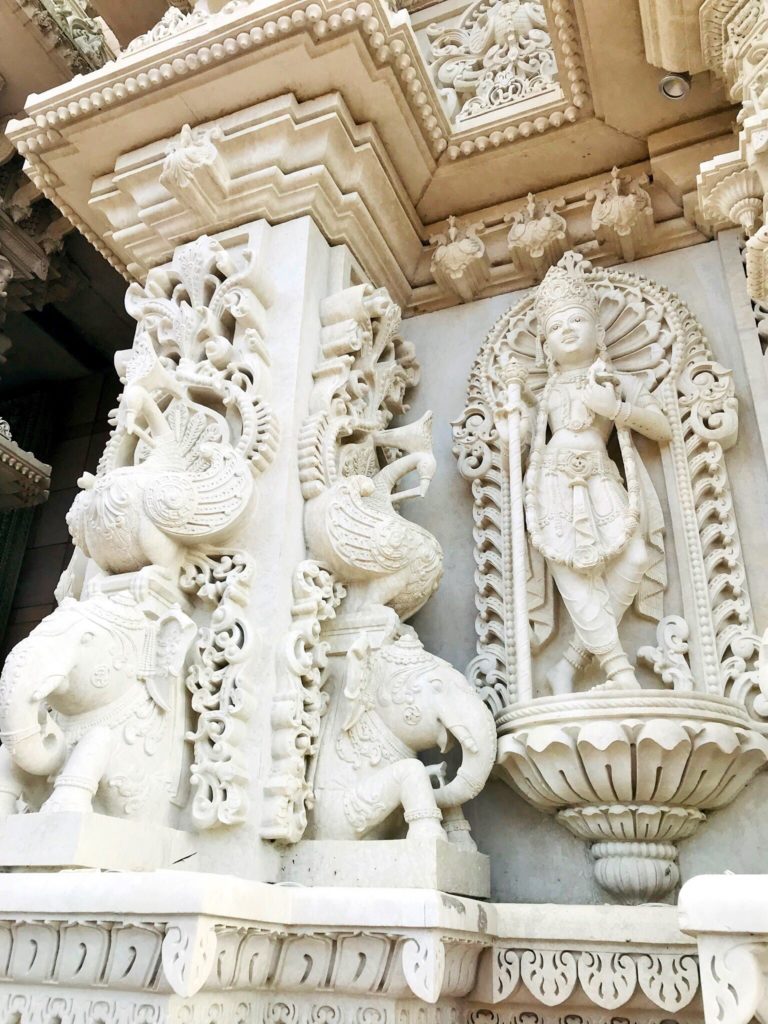

Comments are closed.